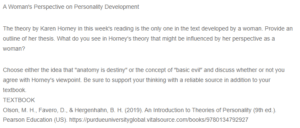Karen Horney’s Personality Development Theory
Karen Horney, a psychoanalyst, developed one of the most popular theories of personality development. She argued that interpersonal relationships, particularly parent-child relationships, greatly influence an individual’s personality development. Accordingly, Horney argued that the satisfaction of a child’s physiological needs did not play a part in personality development but rather, a child’s satisfaction with their need for safety (Hergenhahn & Olson 1999). Consistently, if a parent demonstrates sincere love towards the child and satisfies this need for safety, the child’s personality will grow normally. Contrastingly, if a parent fails to fulfil this need, the child will undergo what Horney termed neurotic development.
Are you interested in obtaining help on your assignment ? Reach out to us.
Further, Horney went ahead to list several behaviours that parents demonstrate that could lead to a child’s neurotic development, including hostility, rejection, humiliation, ridicule, and indifference, to name a few (Hergenhahn & Olson 1999). Neurotic development meant that the individuals would have neurotic needs. At first, she listed ten but later condensed it to three: moving towards people, moving away from people, and moving against people.
Horney’s deviation from intrinsic factors like anatomy to extrinsic factors like upbringing and environment as the determinants of one’s personality demonstrates the influence of being a woman on her perspective. Initially, most theories, like those of Freud, were based on intrinsic factors and were male-centric; however, Horney challenged these views by showing that a woman’s biology is not as influential in her personality development as the environment she grows up in. I support Horney’s concept of elemental evil based on the scientific fact that our environment affects our DNA and behaviours (Krippner & Barrett, 2019; Colangeli, 2020; Roth et al., 2011). For example, suppose one undergoes a traumatic event from an abusive parent; there is a high probability that the stress from this event will alter their DNA, resulting in abnormal behaviour.
References
Colangeli, R. (2020). Bound together: How psychoanalysis diminishes inter-generational DNA trauma. The American Journal of Psychoanalysis, 80(2), 196-218.
Hergenhahn, B. R., & Olson, M. H. (1999). An introduction to theories of personality. Prentice-Hall, Inc.
Krippner, S., & Barrett, D. (2019). Transgenerational Trauma: The Role of Epigenetics. Journal of Mind & Behavior, 40(1).
Roth, T. L., Zoladz, P. R., Sweatt, J. D., & Diamond, D. M. (2011). Epigenetic modification of hippocampal Bdnf DNA in adult rats in a post-traumatic stress disorder animal model Journal of psychiatric research, 45(7), 919-926.
ORDER A PLAGIARISM-FREE PAPER HERE
We’ll write everything from scratch
Question
A Woman’s Perspective on Personality Development
The theory by Karen Horney in this week’s reading is the only one in the text developed by a woman. Provide an outline of her thesis. What do you see in Horney’s theory that might be influenced by her perspective as a woman?

Karen Horney’s Personality Development Theory
Choose either the idea that “anatomy is destiny” or the concept of “basic evil” and discuss whether or not you agree with Horney’s viewpoint. Be sure to support your thinking with a reliable source in addition to your textbook.
TEXTBOOK
Olson, M. H., Favero, D., & Hergenhahn, B. H. (2019). An Introduction to Theories of Personality (9th ed.). Pearson Education (US). https://purdueuniversityglobal.vitalsource.com/books/9780134792927

